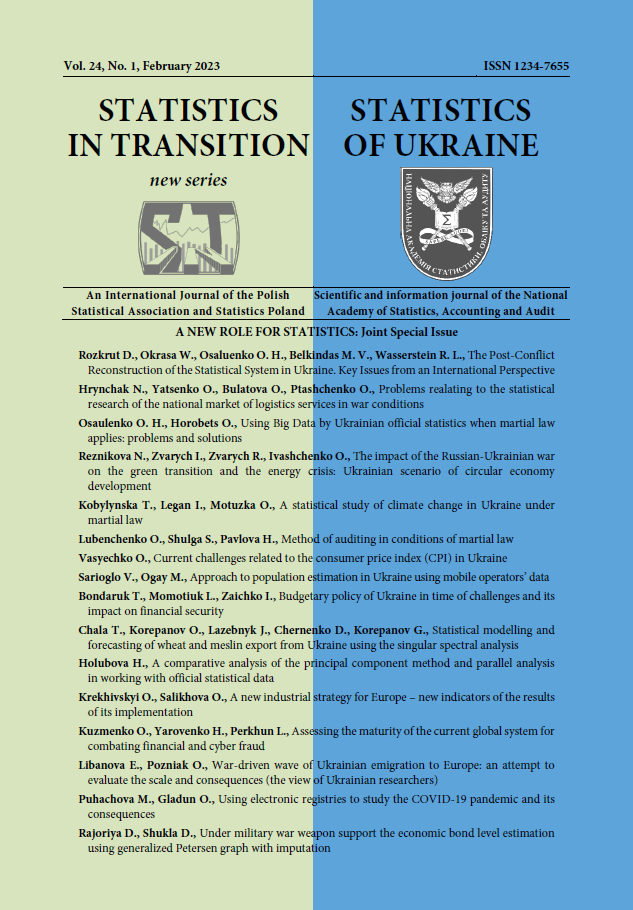© Taisiia Bondaruk, Liudmyla Momotiuk, Iryna Zaichko. Article available under the CC BY-SA 4.0 licence
![]()
ARTICLE
ABSTRACT
Ukraine has recently experienced a significant economic downturn as a result of the COVID-19 pandemic and the war caused by a large-scale military aggression of the Russian Federation. In conditions of the constant fluctuations of the national economy, the stimulating effect of the budgetary policy aimed at minimizing the consequences of such fluctuations and guaranteeing a sufficient level of financial security of the state becomes especially important. The aim of the study is to deepen the theoretical and methodological foundations of the creation and implementation of budgetary policy in Ukraine, evaluation of its impact on the financial security in time of challenges. The study uses methods of comparative analysis, grouping in the process of evaluating the current state of budgetary policy indicators, methods of normalization and standardization of data, modelling, and graphical analysis of data for normalizing the financial security indicators and determining the dynamics of financial security components. The materials and reports containing statistical data from the Ministry of Finance of Ukraine and the State Statistics Service of Ukraine served as the basis of the study. We found out that the components of the financial security of the state in the face of the challenges posed by martial law and the pandemic do not take into account the impact of budgetary policy. We substantiated the thesis that the creation of Ukraine's budgetary policy under martial law requires adjustments to the financial security assessment system. The most statistically significant and reliable models of interrelation were selected for further use in multifactor modelling and forecasting the financial security of the state (on the basis of ranking the linear, polynominal, exponential, logarithmic and power dependencies within one-factor equations). It was experimentally proved that out of 122 statistically significant indicators, budgetary policy indicators such as the coefficient of financing the national functions, the coefficient of public debt service and redemption, and the coefficient of the proportionality of financing the national security agencies had the greatest impact on the financial security of Ukraine. We also substantiated the scientific provisions behind the modelling of the level of financial security of Ukraine taking into account the impact of budgetary policy in the period of challenges. In the process of modelling, the indicators of budgetary policy were identified, while regression analysis revealed the factors influencing the budgetary policy.
KEYWORDS
budgetary policy, financial security, multifactor modelling, linear dependences, polynomial dependences, logarithmic dependences, power dependences.
REFERENCES
Arrow, K. J., (1971). A Utilitarian Approach to the Concept of Equality in Public Expenditures. Quarterly Journal of Economics, vol.85, pp. 409–415.
Bjjukenen, D., (1997). Sochynenyja [Essays]. Moscow: Taurus Aljfa (in Russian). Covid-19 Explorer. Ukraine, (2020). World Health Organization. URL: https://covid19.who.int/explorer.
Heyets, V., Lunina, I., Stepanova, O., (2021). The Formation of Fiscal Space While Overcoming Vaccine Nationalism and Ensuring Sustainability of Development. Science andInnovation, vol. 17, no. 1. pp. 29–41.
Jalowiecki, B., Dziemianowicz, W., (2004). Polityka miejskaa inwestycje zagraniczne w polskich metropoliach [Urban politics and foreign investments in Polish metropolies], Warszawa: Scholar, pp. 134 (in Polish).
Ministry of Finance of Ukraine, (2019). “Bjudzhet Ukrajiny 2018: Statystychnyj Zbirnyk” [Budget of Ukraine 2018. Statistical yearbook] (in Ukrainian), Minfin. Kyiv, Ukraine, pp. 11–12.
Ministry of Finance of Ukraine, (2020). “Bjudzhet Ukrajiny 2019: Statystychnyj Zbirnyk” [Budget of Ukraine 2019. Statistical yearbook] (in Ukrainian), Minfin. Kyiv, Ukraine, pp.11–13.
Musgrave, R., Musgrave, P., Kullmer, L., (1994). Die Öffentliche Finanzen in Theorie und Praxis. Germany: Mohr (in German).
Musgrave, R. A., (1986). Economics of Fiscal Federalism. Public Finance in a Democratic Society: Coll. Papers, vol. 2, pp. 33–41.
Musgrave, R. A., (1959). The Theory of Public Finance: A Study in Public Economy. New York: McGraw-Hill. p. 84.
National Bank of Ukraine. FX market. URL: https://bank.gov.ua/ua/markets/currencymarket.
National Bank of Ukraine. External Sector Statistics. URL: https://bank.gov.ua/statistic/sector-external/data-sector-external#4.
Oates, W. E., (2008) On the evolution of fiscal federalism: theory and institutions. National Tax Journal, vol. 61, pp. 313–334.
Osaulenko, O., Bondaruk, T., Momotiuk, L., (2020). Ukraine’s State Regulation of the Economic Development of Territories in the Context of Budgetary Decentralisation. Statistics in transition new series, vol. 21, no. 3, pp. 129–148.
Samuelson, P., (1955). Diagrammatic exposition of a theory of public expenditure. Review of Economics and Statistics, vol. 37, pp. 350–356.
Shhetynin, A., Uljjanova, L., Chajka, J., (2022). Deficyt derzhavnogho bjudzhetu I derzhavnyj borgh Ukrajiny: suchasnyj stan ta pidkhody do jogho pokrashhennja [State budget deficit and public debt of Ukraine: current state and approaches to its improvement]. Economic space, vol. 179, pp. 37–43.
Stiglitz, J., (2020). Conquering the Great Divide. Finance & Development. URL: https://www.imf.org/external/pubs/ft/fandd/2020/09/COVID19-and-globalinequality- joseph-stiglitz.htm.
Tiebout, C., (1956). A pure theory of local expenditures. Journal of Political Economy, vol. 64, ??. 416–424.
Ministry of Economic Development and Trade of Ukraine (2013) Methodological recommendations for calculating the level of economic security of Ukraine. URL:https://zakon.rada.gov.ua/rada/show/v1277731-13.
